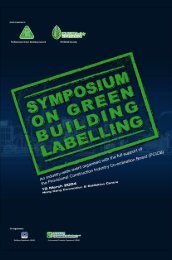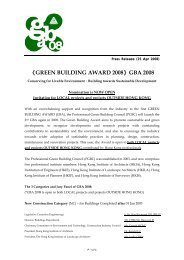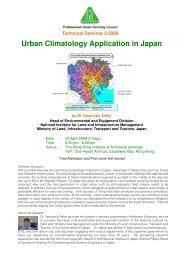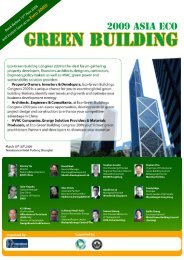r esearch and Planning Studies C ategory (Finalist) - The ...
r esearch and Planning Studies C ategory (Finalist) - The ...
r esearch and Planning Studies C ategory (Finalist) - The ...
You also want an ePaper? Increase the reach of your titles
YUMPU automatically turns print PDFs into web optimized ePapers that Google loves.
BACKGROUND<br />
“Do you think it is possible for you to build us a ‘good’ school?”<br />
New Construction C<strong>ategory</strong> (<strong>Finalist</strong>)<br />
Maosi Ecological Demonstration Primary School<br />
毛 寺 生 態 實 驗 小 學<br />
Location<br />
Completion Date 2006<br />
Maosi village, Xifeng City, Gansu Province, China<br />
Client<br />
Architect<br />
Building Services Engineer<br />
Quantity Surveyor<br />
R<strong>esearch</strong> Investigator /<br />
Sustainable Design / Environmental/<br />
Wind / Specialist Consultant<br />
Owners Association<br />
Other Team Member<br />
Main Contractor<br />
Education Bureau of Xifeng<br />
Department of Architecture,<br />
<strong>The</strong> Chinese University of Hong Kong (Applicant)<br />
Building Design Institute of Qingyang City<br />
Xifeng Audit Centre of Financial Budgeteering<br />
Department of Architecture,<br />
<strong>The</strong> Chinese University of Hong Kong<br />
Maosi Village Government<br />
Department of Architecture, <strong>The</strong> Xian Jiaotong University<br />
Qingyang Si Litian Construction Limited<br />
What is a “good” village school? <strong>The</strong> poor conditions of China’s Loess<br />
Plateau region (north-west China) dem<strong>and</strong> serious re-thinking. <strong>The</strong><br />
fragile ecological conditions, coupled with having some extreme<br />
climatic conditions poses severe environmental <strong>and</strong> sustainable<br />
challenges to designers. <strong>The</strong> poor economy has restricted interventions<br />
<strong>and</strong> solutions. Villagers needing to leave their village homes to find<br />
work in the city further drain the social lineage; they leave their<br />
children behind but still hoping that they can be educated <strong>and</strong> one<br />
day make it in the society. <strong>The</strong>y put their faith in their village schools.<br />
Like many donated schools that have been built in the region, a way<br />
they iconize them is as follows:<br />
“<strong>The</strong> school is very modern with nice white tiles. We take pictures in<br />
front of them when they open. By the way, if they can also install air<br />
conditioners for us in the summer <strong>and</strong> heaters in the winter, it would<br />
be very good as otherwise it can be quite uncomfortable.”<br />
We know for sure that something<br />
needs to be done. <strong>The</strong> project<br />
commenced in 2002. We wished<br />
to build a “demonstration” school<br />
that can showcase appropriateness<br />
<strong>and</strong> can address the environmental,<br />
social <strong>and</strong> economic dimensions of<br />
sustainability.<br />
THE SITE<br />
“<strong>The</strong> village head took the design<br />
team to a site that is south facing <strong>and</strong><br />
surrounded by low hills. He told the<br />
team that it is the best site they have;<br />
<strong>and</strong> he hopes it is good enough for<br />
the school.”<br />
<strong>The</strong> project is located in the village of Maosi, in Gansu province, 6<br />
hours drive from Xian. <strong>The</strong> tranquil <strong>and</strong> unspoiled setting reminds one<br />
that the village <strong>and</strong> its life have always been like that for hundreds if<br />
not thous<strong>and</strong>s of years. It is only very recently that the onslaught of<br />
modernity <strong>and</strong> urbanisation is beginning to intrude. <strong>The</strong> village has<br />
around 2500 villagers <strong>and</strong> 200 students. <strong>The</strong>ir existing schools are either<br />
in caves or in simple single storey brick huts.<br />
METHODOLOGY <strong>and</strong> DESIGN<br />
“High science <strong>and</strong> low technology is a motto of the working.”<br />
<strong>The</strong> project emphasizes a scientific <strong>and</strong> transferable methodology:<br />
condition analysis, computer simulation experiments <strong>and</strong> field<br />
construction.<br />
Condition analysis in economy & resource for building, climate, <strong>and</strong><br />
vernacular architecture deduce that thermal design for this region is<br />
the most effective approach towards ecological architecture, <strong>and</strong> both<br />
design <strong>and</strong> construction should follow these principles: comfortable<br />
indoor ambience, cost-effectiveness, minimum embodied energy<br />
<strong>and</strong> construction ease. <strong>The</strong> investigation is further by with thermal<br />
simulation experiments. By filtering <strong>and</strong> optimizing locally available<br />
materials <strong>and</strong> techniques, it is found that the most basic techniques of<br />
thermal mass <strong>and</strong> insulation based on earth <strong>and</strong> natural materials can<br />
be very effective; they should be strategically employed.<br />
新<br />
建<br />
建<br />
築<br />
類<br />
別<br />
入<br />
圍<br />
44 45










